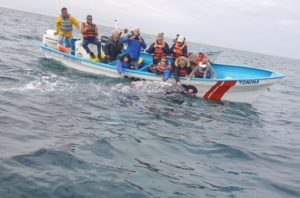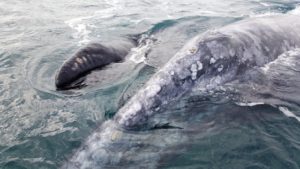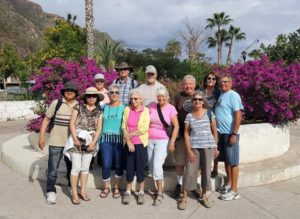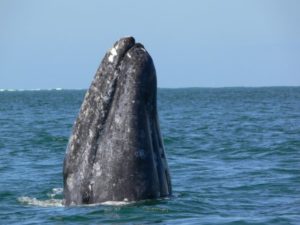February 23, 2018 –

Hard to believe we were surrounded by 1,200 grey whales in the bay. We had stopped our panga to see one spy hopping, which is the whale coming straight up out of the water with his eyes out of the water looking around, when we were surprised. None of us could believe it when a huge female headed right at us. Little did we know she was bringing her very young baby to introduce us and allow us to pet both her and her offspring for over a half hour!. It was magical. Here’s the pictures to prove it.

Did you know?
Gray whale watching season begins in early December along the Pacific coast of Baja California and ends in early April in the same location. In the weeks in the whales will venture as far south as Cabo Pulmo and Cabo San Lucas to winter, before turning around and heading north again to summer in arctic waters.
Some of the Pacific Bays and lagoons of Baja California Sur are calving grounds for the gray whales and extraordinary up close experiences can be had with what have grown to be known as the Friendly Whales. This year whale counters are reporting more than a 60% increase in the number of mothers and calves showing up in the nursery areas. So it might be a very good year to get up close and personal with a gray whale.

When visiting to go whale watching be sure your tour has the appropriate state and federal licenses. It is not legal for just anyone to take you whale watching. Official tour guides must pass a course in protection and observation of the species. Vessels must also pass a passenger safety inspection. This limits the number of boats crowding close to the animals and should help to reduce harassment of the wonders of the sea and vessel inspections are to the benefit of the tourist.
There are a number of places to go whale watching, but by sheer tourist volume, more people see whales in Cabo San Lucas than anywhere else. But some of the best places to have up close encounters with what are usually gray whales are in San Ignacio Lagoon, Scammon’s Lagoon and Adolfo Lopez Mateos. To a great extend these communities LIVE for the whale watching season. Small motel/hotels and quaint seafood restaurants are part of the thrill of the adventure. In my 16 years in Baja, some of these areas have seen significant growth because of the whale watching industry.

For thousands of years, the gray whales have migrated to Baja in the winter to bear their young in the warm and placid waters surrounding the Baja Peninsula. The gray whale migration takes them south past the west coast of the United States and the Pacific coast of Baja. Scammon’s Lagoon and Bahia San Ignacio are some of the most famous places to see gray whales. San Ignacio boasts the ‘friendly whales’, a pod that seems to have over some time, developed an affinity with the tourists that come to whale watch in Baja.
Gray whales are 52 feet long and weigh 36 tons, yet are gentle enough to touch… and Baja California’s Pacific coast is the perfect place to experience the thrill! Every year in November, more than 10 thousand gray whales trade the freezing waters of Alaska’s Bering Sea for the warmth of Mexico’s Baja California Peninsula. Traveling along the Pacific coastline at top speeds of five mph and with pregnant females in the lead, the whales take about four months to make the 10 thousand miles roundtrip.

Hunted for their oils, blubber, and other valuable products, gray whales were once victims of massive slaughter in the 1800s and early 20th century. The hunting continued until the numbers were reduced to only a few hundred, and the whales were subsequently placed on the endangered species list. Thanks to an international protection agreement made among several countries in the 1940s, the whales’ numbers have grown at an incredible rate. Today, more than 30,000 gray whales exist and although still protected, they were removed from the endangered species list in 1975. Gray whales are among the oldest species of mammals, inhabiting the Earth for about 30 million years.

Once the whales reach the Mexican coast, they mate, bask in soothing lagoons and give birth, making January through early April the peak time to whale watch. During these months, boat excursions are available all along Baja California, giving tourists the chance to observe these magnificent creatures in their natural environment, see the newborn calves and enjoy the blowhole water shows. Gray whales are so friendly that on many occasions they swim right up to the boats and even allow human contact. In early spring, the calves and their mothers are the last to head back up north, and without the presence of the males, mothers are less protective, often allowing their young to approach tour boats more freely.



